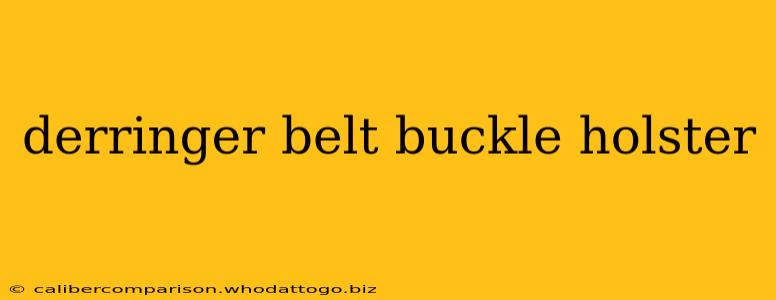The derringer pistol, known for its compact size and potent stopping power, has long been a favorite of those seeking concealed carry options. While traditional holsters exist, the derringer belt buckle holster offers a unique level of concealment and convenience. This guide explores the pros, cons, and considerations for choosing a derringer belt buckle holster.
What is a Derringer Belt Buckle Holster?
A derringer belt buckle holster cleverly integrates a holster into a standard belt buckle. The design allows for the derringer to be concealed completely beneath clothing, offering a significantly more discreet carry method than traditional IWB (Inside the Waistband) or OWB (Outside the Waistband) holsters. The pistol is typically held securely within the buckle itself, accessed by simply unbuckling the belt.
Advantages of Derringer Belt Buckle Holsters
- Ultimate Concealment: This is the primary advantage. The design inherently hides the firearm, making it ideal for situations where a more visible holster would be impractical or undesirable.
- Convenience: The holster is always readily available as it's part of your belt buckle. No fumbling with separate holsters or adjustments.
- Discreet Access: While quick access isn't as fast as some other holsters, the design allows for relatively quick retrieval when needed.
- Comfortable Carry: Because the weight is distributed across the buckle, it is generally more comfortable than some other carry methods, particularly for smaller-framed individuals.
Disadvantages of Derringer Belt Buckle Holsters
- Limited Gun Selection: These holsters are specifically designed for derringers and generally won't accommodate other firearm types. The fit is critical for both security and ease of access.
- Draw Speed: The unbuckling process adds a small but noticeable delay to the draw time compared to traditional holsters. Practice is essential.
- Durability Concerns: The buckle's construction needs to be sturdy enough to withstand repeated use and stress. Lower-quality materials may lead to breakage or malfunction.
- Retention: While good quality holsters prioritize secure retention, it’s crucial to choose a holster with a strong retention mechanism to prevent accidental discharge or loss of the firearm.
Choosing the Right Derringer Belt Buckle Holster
Selecting the right holster requires careful consideration of several factors:
- Material: Look for durable materials like high-quality leather or strong polymers.
- Retention: The holster should securely hold the derringer, even during vigorous activity. Test the retention mechanism before purchasing.
- Fit: Ensure a precise fit for your specific derringer model. A poorly fitting holster can affect both comfort and safety.
- Comfort: Consider the buckle's design and overall weight distribution to ensure comfortable all-day wear.
- Legality: Always be aware of and adhere to local, state, and federal laws regarding concealed carry.
Conclusion:
Derringer belt buckle holsters offer a unique approach to concealed carry, emphasizing discretion and convenience. However, they're not without limitations. By carefully weighing the advantages and disadvantages and selecting a high-quality holster that meets your needs and legal requirements, you can find a discreet and reliable carry solution. Remember, proper training and safe handling practices are crucial regardless of the chosen holster. This information is for educational purposes only and does not constitute legal or safety advice. Always consult with relevant authorities and professionals for guidance.

